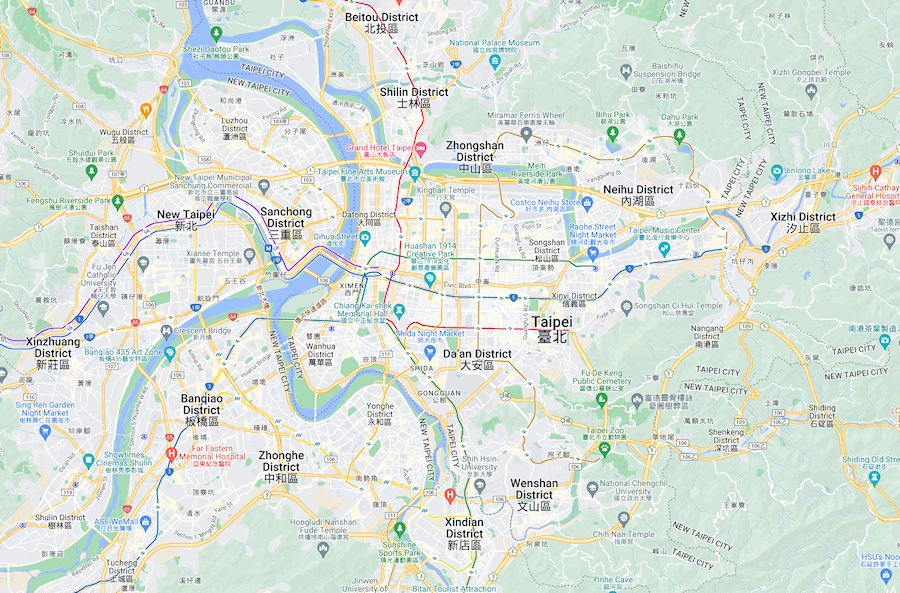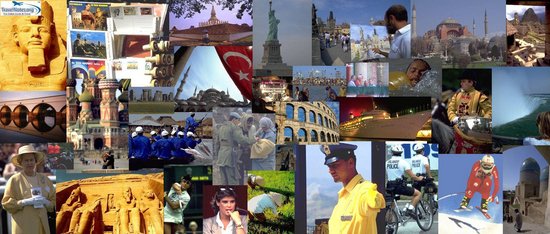Travel Notes: Asia - Taiwan Travel Notes.
Short URL: https://tnot.es/TW
Taiwan Travel and Tourism on Travel Notes
Taiwan Tourist Delights - Travel Beyond Taipei's Towering Skyline
Explore Taiwan beyond Taipei and experience its diverse culture and natural wonders. Plan your perfect itinerary with our travel tips and recommendations. Share on Facebook
About Taiwan
Taiwan is known for its natural beauty and delicious cuisine. Tourist destinations include Taroko National Park, Jiufen, hot springs, and Taipei Palace Museum.
Nomadic Gatherings
Arrival in Taiwan - Tainan, Former Capital - Chungshan Park - Bus Travel in Taiwan - Travel to Chiayi - Bus to Taipei - Restaurant in Taipei.
 Add a Business -
Add a Location -
Add a Lodging - Add Travel Content
- Add URL
- Travel Services.
Add a Business -
Add a Location -
Add a Lodging - Add Travel Content
- Add URL
- Travel Services.
Mapping The Republic of China
Map of Taiwan
Taiwan was named Formosa (beautiful island) by the Portuguese; the first Europeans to pay the island a visit, in 1590.
Taiwan Overview
Taiwan, officially known as the Republic of China (ROC), is an island nation located in East Asia; situated off the south-eastern coast of mainland China, across the Taiwan Strait, and to the south-west of Japan's Okinawa Island.
Taiwan is a dynamic and prosperous island nation with a unique history and culture, playing a significant role in the global economy and geopolitics.
Culture
Taiwanese culture is a blend of indigenous, Chinese, Japanese, and Western influences.
The island has a vibrant arts scene, including traditional Chinese opera, puppetry, and contemporary art.
Taiwanese cuisine is also diverse and renowned, with dishes such as beef noodle soup, bubble tea, and night market snacks gaining popularity worldwide.
Economy
Taiwan has a highly developed economy, known for its advanced technology industry, including semi-conductors, electronics, and information technology.
It is one of the Four Asian Tigers known for its rapid industrialisation and economic growth in the latter half of the 20th century.
Government and Politics
Taiwan operates under a democratic system with a president as the head of state and a premier as the head of government.
The political landscape is dominated by several major parties, including the Kuomintang (KMT) and the Democratic Progressive Party (DPP).
History
Taiwan's history is rich and complex.
Indigenous peoples inhabited the island for thousands of years before the arrival of Chinese settlers in the 17th century.
In the late 19th century, Taiwan was ceded to Japan after the First Sino-Japanese War.
After World War II, Taiwan was returned to Chinese control, and the Republic of China government retreated to the island following the Chinese Civil War in 1949.
International Status
Taiwan is not a member of the United Nations due to pressure from China, which considers it a renegade province.
However, it maintains unofficial diplomatic relations with many countries and participates in various international organisations under the name 'Chinese Taipei'.
Relations with Mainland China
Taiwan's relationship with mainland China is complicated and often tense.
While both sides officially adhere to the 'One China' policy, they have separate governments and political systems.
China claims Taiwan as its territory and has not ruled out the use of force to achieve reunification, while Taiwan maintains de facto independence and seeks international recognition as a sovereign state.
Visiting Taiwan
Visiting Taiwan offers a wide range of experiences, from exploring bustling cities to absorbing serene natural landscapes.
This visitor's itinerary provides a comprehensive overview of Taiwan's diverse attractions, allowing you to experience the island's rich culture, stunning natural beauty, and delicious cuisine.
Jiufen and Keelung
Golden Waterfall and Yehliu Geopark
Explore the unique rock formations at Yehliu Geopark and visit the nearby Golden Waterfall.
Jiufen
Visit the charming mountain town of Jiufen, about an hour north-east of Taipei, known for its narrow shopping streets, traditional tea houses, and stunning views of the ocean.
Keelung
Explore the bustling port city of Keelung and sample fresh seafood at the Miaokou Night Market.
Keelung includes seven islands within its city limits, and holds historical significance as the location where the Spaniards first built a fortified settlement in Taiwan, in 1626.
Tainan and Kaohsiung
Fo Guang Shan Buddha Memorial Centre
Visit Fo Guang Shan Buddha Museum, one of the largest Buddhist shrines in the world, and admire its majestic architecture and serene atmosphere.
Kaohsiung
Discover Taiwan's second-largest city, Kaohsiung; known for its vibrant arts scene, night markets, and waterfront attractions.
Visit highlights like Pier-2 Art Center, Lotus Pond, and Cijin Island.
Tainan
Tainan is Taiwan's oldest city; known for its rich history, temples, and traditional cuisine.
Visit attractions like Anping Old Fort, Chihkan Tower, and the Confucius Temple.
Taipei
National Palace Museum
Explore one of the world's largest collections of Chinese art and artifacts in the National Palace Museum, including ancient bronzes, ceramics, and paintings.
Night Markets
Sample Taiwanese street food at famous night markets like Shilin Night Market and Raohe Street Night Market.
Taipei 101
Make time to visit Taipei 101, one of the world's tallest skyscrapers.
Enjoy panoramic views of the city from the observatory.
Taipei Teahouse
When in Taipei, consider visiting a traditional tea house to relax and reflect on your visit to Taiwan.
Ximending
Experience Taipei's vibrant youth culture and entertainment district, Ximending; located in the north-eastern part of the Wanhua District in Taipei.
Explore its shops, restaurants, and street performers.
The area features the first pedestrian zone in Taipei, the Honglou Theatre, and a tattoo street.
Yangmingshan National Park
Take a day trip to the beautiful Yangmingshan National Park, located in the north of Beitou; to enjoy hot springs, hiking trails, and stunning volcanic landscapes.
Taroko Gorge and Hualien
Hualien
Explore the charming coastal city of Hualien, known for its laid-back atmosphere and delicious local cuisine.
Don't miss the chance to try taro balls and other traditional snacks.
Qixingtan Beach
Relax on the black sand beach of Qixingtan and enjoy views of the Pacific Ocean.
Taroko Gorge
Journey to Taroko Gorge National Park, one of Taiwan's most spectacular natural attractions.
Hike along its breathtaking trails, visit temples, and marvel at the marble cliffs and rushing rivers.
Taiwan Background
Following most of Chinese mainland's occupation by Communist armies, General Chiang Kai-shek moved the Nationalist government of China's headquarters to T'ai-pei, on December 8, 1949.
During the 1950s, the United States vowed to take military action against the Chinese mainland if Communist forces attacked Taiwan or the Pescadores.
With extended financial and military aid from the US, during the early 1960s, Taiwan was able to build its economy.
The mainlanders who had taken refuge in 1949 continued to dominate the political stage, but Taiwan was becoming isolated as countries sought to strengthen ties with the larger market in mainland China.
Neither of the Chinese governments would have formal relations with any nation recognising the other.
The Democratic Progressive party (DPP) continue to campaign for Taiwan's independence from mainland China, while Beijing threatens military action if this ever happens.
The People's Republic of China claim Taiwan as one of its provinces and some native Taiwanese resent the claims.
Posturing and flexing of navy muscle is not uncommon in the South China Sea.
Nomadic Gatherings
Chapter Three:
Taiwan was a brief stop en-route from Seoul to Hong Kong. They found it
amusing that I was heading for China.
Taiwan Travellers
Travel to Taiwan:
From the island's tallest building to its tallest peak, Taiwan has
something exceptional to offer every kind of traveller.
Get Me to Taiwan
The Taiwanese are warmhearted, honest and hospitable, and relaxing wild forests and high mountains are always within an hour’s drive.
To travel through a land where tradition and modernity blend together seamlessly, join a group of storytellers who have fallen in love with Taiwan and want to share the island's beauty with you.
Taipei
Map of Taipei
You can also call it T'ai-pei or Taibei; whatever, it's the provisional capital of the Republic of China, or Taiwan.
Located on the Tanshui River, near the north coast of Taiwan, you will fly into T'aoyuan International Airport.
ImmiImmigrants from mainland China's Fujian Province first settled here in the 18th century, but not a lot was happening.
The Japanese brought sushi to the island between 1895 and 1945, until they surrendered the island to China after World War II.
Where to Stay in Taiwan
Taipei Sightseeing
Among all the neon light, there are some Buddhist shrines of interest in Taipei.
The Memorial Hall to Chiang Kai-Shek is a large white marble structure with an enormous blue-tiled roof, surrounded by an impressive garden.
Museums in Taipei
The National Palace Museum contains Chinese art treasures from the 2nd millennium BC to the 20th century, and the Hwa Kang Museum has displays of folk and modern Chinese art.
Taiwan Tourist Shuttle Service
The Taiwan Tourist Shuttle Service is designed to transport people without a car to Taiwan's major tourist attractions.
T'ai-nan
The Chinese pirate, Koxinga, made the city his capital due to its convenient position on the south-west of the island.
It remained the capital of the island until 1885, when the government was transferred to T'ai-pei.
Sincere Hotel:
No 133 Ta Ying Tsun Hsin Shin.
This European-style hotel, built around a field of beautiful
landscaped gardens, is a tranquil, comfortable and well-equipped establishment with
Internet service in every room.
Language and Culture
The official language of Taiwan is Mandarin, although other Chinese dialects are also spoken.
The Taiwanese are mostly descendants of the Chinese who emigrated from Fujian and Guangdong provinces during the 18th and 19th centuries.
The Taiwanese celebrate many ancient Chinese customs and holidays, especially the Dragon Boat Festival, the Mid-Autumn Festival, and the Feast of Lanterns.
Taiwan Travel Guides
Taiwan Travel Guides - Taiwan Maps.
Weather in Asia:
Local weather forecasts for destinations around Asia.
|
|
More From Travel Notes
Travel Notes Online Guide to Travel
Africa - Asia - Caribbean - Europe - Middle East - North America - Oceania - South America.
The Travel Notes Online Guide to Travel helps visitors plan their trip with country and city travel guides, local tourist information, reviewed web sites, and inspiring travel content.
Travel and Tourism Guides on Travel Notes
 If you find Travel Notes useful, please take a moment to
like us on Facebook and share with your friends on social media.
If you find Travel Notes useful, please take a moment to
like us on Facebook and share with your friends on social media.
Share on Facebook
Travel Resources
.
Travel & Tourism With Industry Professionals.














